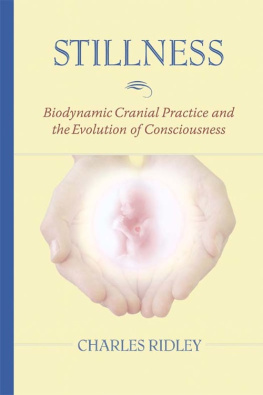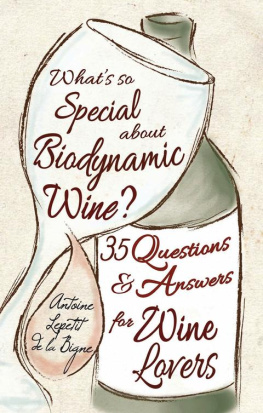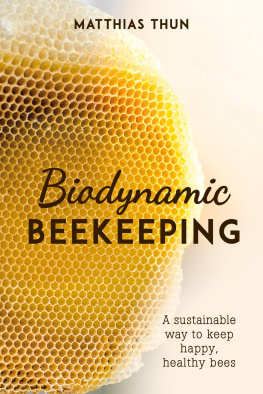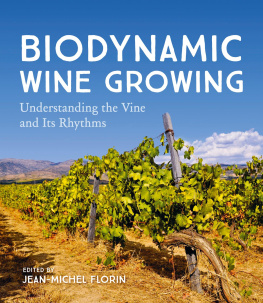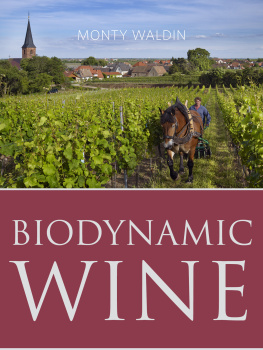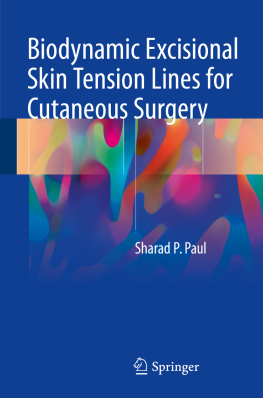Copyright 2006 by Charles Ridley. All rights reserved. No portion of this book, except for brief review, may be reproduced, stored in a retrieval system, or transmitted in any form or by any means electronic, mechanical, photocopying, recording, or otherwise without the written permission of the publisher. For information contact North Atlantic Books.
| Published by |
| North Atlantic Books | Cover art by Michael Ferguson |
| P.O. Box 12327 | Cover design by Jan Camp |
| Berkeley, California 94712 | Cover image of Fetus 2006 JupiterImages Corporation |
Stillness: Biodynamic Cranial Practice and the Evolution of Consciousness is sponsored by the Society for the Study of Native Arts and Sciences, a nonprofit educational corporation whose goals are to develop an educational and cross-cultural perspective linking various scientific, social, and artistic fields; to nurture a holistic view of arts, sciences, humanities, and healing; and to publish and distribute literature on the relationship of mind, body, and nature.
North Atlantic Books publications are available through most bookstores. For further information, visit our website at www.northatlanticbooks.com or call 800-733-3000.
Library of Congress Cataloging-in-Publication Data
Ridley, Charles.
Stillness: biodynamic cranial practice and the evolution of consciousness / by Charles Ridley.
p.; cm.
Includes bibliographical references.
Summary: A guide for practitioners by a professional known for non-medical biodynamic therapy synthesized from the craniosacral tradition and contemporary understandings of mind-body interaction, energy medicine, new science, and bodywork; careful explications of how both practitioner and client can learn to access and heighten felt body-self consciousness. Includes exercisesProvided by publisher.
eISBN: 978-1-58394-586-5
1. Craniosacral therapy. 2. Consciousness. I. Society for the Study of Native Arts and Sciences. II. Title.
[DNLM: 1. Physical Therapy Modalities. 2. Cerebrospinal Fluid. 3. Complementary Therapiesmethods. 4. Consciousness. 5. Mind-Body Relations (Metaphysics) 6. Sacrum. 7. Skull.
WB 890 R545s 2006]
RZ399.C73R53 2006
615.82dc22
2006009741
v3.1_r1
When in the morning I looked upon the light I felt in a moment that I was no stranger in this world, that the inscrutable without name and form had taken me in its arms in the form of my own mother.
R ABINDRANATH T AGORE , Gitanjali
To the Momma
C ONTENTS
P REFACE
In February 1951, after fifty years of pioneering cranial work, Dr. William Garner Sutherland moved from the Midwest to Pacific Grove, California: We live close to the lighthouse by the sea and view the water of the Pacific day by day; and even when we do not see the sea we feel the presence of the fluid tide. It was in his house by the sea that a new consciousness ignited in Dr. Sutherland and his theory of biodynamics was born. Of his awakening, he left only hints, but enough to point the way to his discovery:
So, read the space between both the lines of smudge and the print. Also, read the space between the physiologic centers within the floor of the fourth ventricle. In reading between the lines we suggest the mental vision through the small end of the microscope, followed by the view through the big end of a telescope to observe the material elements disappearing into endless space.
In his writings, Dr. Sutherland underlined key words that transmit information hidden between the lines. Dr. Sutherland died before he thoroughly documented his discovery. Even so, inscribed on his headstone, which sits across from the lighthouse one block from his house on the sea, Dr. Sutherland left his final words, Be Still and Know.
Dr. Becker characterized many of the principles of biodynamics, and established the sensing skills that place practitioners in direct contact with the slower, more global rhythms of primary respiration that are beyond the cranial wave. And now we bask in the light of the elegant refinements, precise definitions, and clarifications provided by Dr. Beckers student, Dr. James Jealous, who has thoroughly evolved Dr. Sutherlands original transmission, putting biodynamics on solid ground. I am in awe of Dr. Jealous dedication, and in this book, I abide by the definitions he has given us.
Although I rest upon the shoulders of these three cranial pioneers, the biodynamics I teach is different in many ways. I propose that the five known cranial enfoldments are aspects of human consciousness; therefore, biodynamic cranial practice is a means for evolving your inner development. I assert this because biodynamic principles are steeped in perennial wisdom as were all healing arts before scientific medicine squeezed the life out of them. Also, the latest findings from new science, biology, integral consciousness, mind-body, and energy medicine have helped restore validity to the healing sciences. This new science frees biodynamic principles from its mechanical tradition.
Biodynamics is an ever-evolving living organism, and I suspect that many cranial practitioners feel its call and deeply resonate with its principles, but do not know how to proceed. So, I have provided inner practices that will provide you with a smooth transition from the practice of intervention to the practice of non-doing, which is essential to biodynamics. These tonal match exercises will lay you at the door of a neutral, and in direct contact with primary respiration (so named because it is prior to thoracic respiration), where inherent healing begins. This book, then, fills a gap in the cranial field by offering non-dual practitioner preparation.
Next, this book validates cranial practitioners who already experience deeper, slower rhythms that are not on the cranial wave map, and aims to help them articulate what they feel. When I first encountered deeper enfoldments, I had no language or map for those experiences, so I was worried that I was going crazy. This motivated me to articulate what I feel, and perhaps it will also speak to your experiences.
Lastly, biodynamics practitioners who already float in the sea of the Breath of Life will discover new ways to refine their sensing skills that will open the doors even wider into what Dr. Sutherland referred to as the endless space. Moreover, you will learn how to be unwaveringly present, no matter how sublime your encounter with the Breath of Life.
If you are a health practitioner who is not in the cranial field, you can also benefit from this book. If you abide by the biodynamics principles I outline here, along with exploring the tonal match practices as they apply to your work you can transpose my cranial presentation, so that it fits with your healing practice, be it acupuncture, homeopathy, psychotherapy, naturopathy, medicine, spiritual healing, bodywork, movement, Somatic Experiencing, and so on. After all, the Breath of Life made the body, and heals it, no matter what modality it operates through.
As compared to other biodynamic approaches, I will teach you how to leave the Breath of Life free to heal. This is nonmedical biodynamics Breath of Life Cranial Touch and I will point out repeatedly why its important not to use techniques or intentions, but instead to abide in your heart, maintain unwavering presence, and leave the healing to the Breath of Life.
This clinical use of the Breath of Lifes healing potency belongs to osteopathic medicine. It is not my path.
If practicing my techniques points you to your way (which you will discover for yourself), then I have succeeded. What I teach is not

